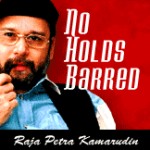How to bring a government down

The Perak Menteri Besar has just had his audience with His Highness the Sultan of Perak to request Tuanku’s consent to dissolve the Perak State Assembly. It seems the Sultan wants to ‘think about it’ first and will probably make his decision after seeing Deputy Prime Minister Najib Tun Razak tomorrow. Maybe, while Tuanku is at it, he can also think about the following.
NO HOLDS BARRED
Raja Petra Kamarudin
Westminster system
The Westminster system is a democratic parliamentary system of government modelled after the British government (the Parliament of the United Kingdom). The term comes from the Palace of Westminster, the seat of the UK Parliament.
The system is a series of procedures for operating a legislature. It is used, or was once used, in the national legislatures and sub-national legislatures of most Commonwealth and ex-Commonwealth nations, beginning with the Canadian provinces and Australian colonies in the mid-19th century. There are other parliamentary systems whose procedures differ considerably from the Westminster system.
Key characteristics
Important features of the Westminster system include the following, although not all of the following aspects have been preserved in every Westminster-derived system:
* a sovereign or head of state who is the nominal or theoretical holder of executive power, and holds numerous reserve powers, but whose daily duties mainly consist of performing the role of a ceremonial figurehead. Examples include the British monarch, the presidents of many countries and state/provincial governors in federal systems.
* a head of government (or head of the executive), known as the prime minister (PM), premier or first minister, who is officially appointed by the head of state. In practice, the head of government is almost always the leader of the largest elected party in parliament.
* a de facto executive branch usually made up of members of the legislature with the senior members of the executive in a cabinet led by the head of government; such members execute executive authority on behalf of the nominal or theoretical executive authority.
* parliamentary opposition (a multi-party system).
* an elected legislature, often bicameral, in which at least one house is elected, although unicameral systems also exist; legislative members are usually elected by district in first-past-the-post elections (as opposed to country-wide proportional representation).(In this case, New Zealand presents an interesting change given its shift to proportional representation.)
* a lower house of parliament with an ability to dismiss a government by "withholding (or blocking) Supply" (rejecting a budget), passing a motion of no confidence, or defeating a confidence motion. The Westminster system enables a government to be defeated, or forced into a general election, independently of a new government being chosen.
* a parliament which can be dissolved and elections called at any time.
* parliamentary privilege, which allows the Legislature to discuss any issue deemed by itself to be relevant, without fear of consequences stemming from defamatory statements or records thereof.
* minutes of meetings, often known as Hansard, including an ability for the legislature to strike discussion from these minutes.
Most of the procedures of the Westminster system have originated with the conventions, practices and precedents of the Parliament of the United Kingdom, which are a part of what is known as the Constitution of the United Kingdom. Unlike the unwritten British constitution, most countries that use the Westminster system have codified the system in a written constitution.
However, uncodified conventions, practices and precedents continue to play a significant role in most countries, as many constitutions do not specify important elements of procedure: for example, some older constitutions using the Westminster system do not mention the existence of the cabinet and/or the prime minister, because these offices were taken for granted by the authors of these constitutions.
A motion of no confidence (alternatively vote of no confidence, censure motion, no-confidence motion, or confidence motion) is a parliamentary motion traditionally put before a parliament by the opposition in the hope of defeating or weakening a government, or, rarely by an erstwhile supporter who has lost confidence in the government. The motion is passed or rejected by means of a new parliamentary vote (a vote of no confidence).
Typically, when parliament votes no confidence, or where it fails to vote confidence, a government must respond in one of two ways:
* resign
* seek a parliamentary dissolution and request a general election

